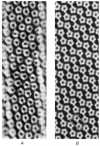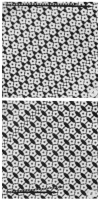Polyoma virus 'hexamer' tubes consist of paired pentamers
- PMID: 6304526
- PMCID: PMC4140084
- DOI: 10.1038/303446a0
Polyoma virus 'hexamer' tubes consist of paired pentamers
Abstract
The discovery that the 72 capsomeres of the icosahedrally symmetric polyoma virus capsid are all pentamers shows that the expected quasi-equivalent bonding specificity is not conserved in the assembly of this virus coat protein. Tubular particles produced by polyoma and other papovaviruses seem to be polymorphic aggregates of capsomeres that may arise through variation in switching of the bonding specificity. Electron micrographs of wide and narrow classes of tubes were analysed by Kiselev and Klug using optical diffraction and optical filtering methods. The wide type were called 'hexamer' tubes because they consist of approximately hexagonally arrayed capsomeres that were assumed to be hexamers, in accord with the quasi-equivalence theory of icosahedral virus particle construction. The narrow type were called 'pentamer' tubes because the capsomeres are arrayed in a particular 'pentagonal tesselation' which arises from the pairing of pentamers across 2-fold axes of the surface lattice. Our reexamination of negatively-stained polyoma virus tubes by digital image processing of low-irradiation electron micrographs shows that all tubes are assemblies of paired pentameric capsomeres. We report here that the packing arrangement of the pentamers in the hexamer tubes is simply related to the pentagonal tessellation respresenting the packing in the narrow pentamer tubes. In all the tube structures examined, at least one pairwise contact between neighbouring pentamers closely resembles the contact between the pentavalent and hexavalent capsomeres in the icosahedral capsid.
Figures




